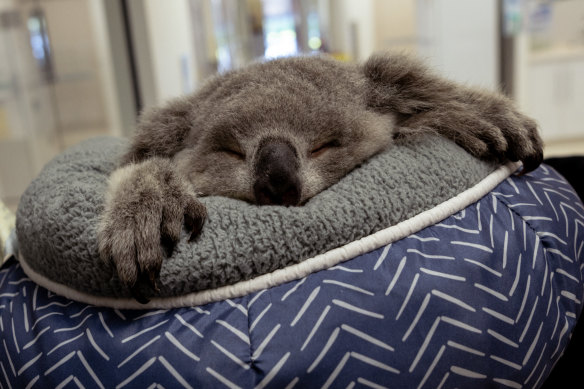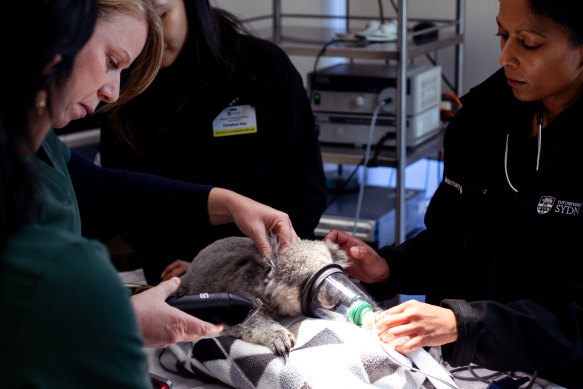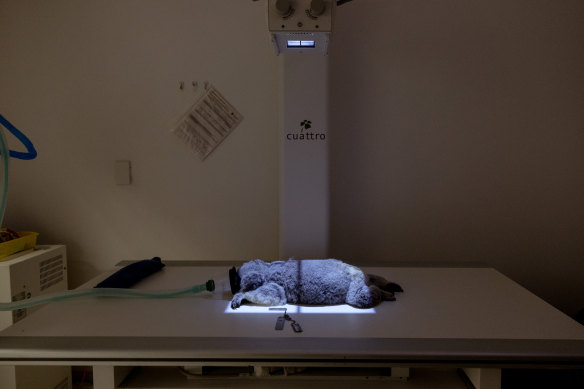Finally, a good news koala story
Trials for a vaccine to prevent chlamydia in one of our most beloved native animals are yielding promising results.

Baby CC, a rescue joey, receives regular checkups at the Wildlife Health and Conservation Hospital in southwestern Sydney.Credit: Dominic Lorrimer
The rescued baby koala is turning her ears like radar dishes as she gazes around the veterinary surgery. The rest of a koala’s anatomy you can steel yourself against: the mild amber eyes, the big black nose, the little rounded back. But the ears – big and velvety grey, with white fluff exploding out of them – are the ears of an animal from a fairytale; one who can take your heart in one tiny, pterodactyl-clawed hand and crush it like a bug. This is why I could never be a wildlife vet, or a wildlife carer, or even, generally, a journalist who covers koalas: because all stories about them these days are sad stories and, frankly, I can’t bear to read them, let alone write them.
But if you, dear reader, are in the same boat, then this is the story for you. Trust me. This is a good-news koala story. At last.
One piece of bad news before the good news begins: chlamydia. Specifically, chlamydia pecorum, which causes the disease chlamydiosis, commonly known as chlamydia. Bad for anyone, but especially for koalas – who catch it just the way humans do (by having sex) – for whom its impacts are devastating, that is terrible urinary tract infection and pain, incontinence, skin ulceration and inflammation, and massive cysts on ovaries and prostates leading to serious scarring and permanent infertility. Some koalas also get ocular infections, such as severe conjunctivitis and blindness.
All over Australia, koala populations are being slowly but surely decimated as chlamydia rates rise, especially in NSW and Queensland, where once healthy groups – like that at Gunnedah, in NSW, which still calls itself the world’s “koala capital” – are now functionally extinct. Already listed as endangered in both states and the ACT, already battling multiple perils – habitat loss, drought, fire, car strike, dog attack – chlamydia may be the final nail in the koala’s coffin.
According to the Australian Koala Foundation, there was an estimated 30 per cent decline in koala numbers in the space of just three years, 2018-2021, with the entire national population in 2021 estimated to be, at best, less than 60,000 animals. (NSW was the worst of any state, with a 41 per cent decline.) And though the causes vary between populations, in at least some places – like Gunnedah, where up to 85 per cent of koalas have chlamydia – the disease is the primary cause of the decline.

CC undergoes regular testing for chlamydia.Credit: Dominic Lorrimer
In humans, the standard treatment for chlamydia is antibiotics. But in koalas, which have a unique gut microbiome that allows them to process their diet of toxic eucalypt leaves, antibiotics can be catastrophic, because (just as in humans) they destroy digestive bacteria. This means some animals die of gastrointestinal issues like diarrhoea or malnutrition during treatment: literally killed by their cure.
But now, at last, there’s an alternative: a vaccine against chlamydia. Which means that the baby koala in the Wildlife Health and Conservation Hospital at south-west Sydney this morning – whose name, by the way, is CC (pronounced CeeCee, and yes, she does seem like the sort of koala who might wear a beret) – has, at last, a chance at a disease-free future.
In humans, chlamydia is the most common sexually transmitted bacterial infection on earth. It’s also rife in the animal kingdom, occurring in everything from parrots to frogs. In fact, professor Ken Beagley from the Queensland University of Technology (QUT) worked on the human vaccine before turning to a koala version. In 2021, he and his team launched a five-year trial with Currumbin Wildlife Hospital on the Gold Coast. Now in its third year, more than 40 wild koalas from the nearby Elanora koala population have so far been caught, vaccinated, boosted and released. They’re then re-caught and re-tested every six months.
Elanora koalas have the highest rate of chlamydia on the Gold Coast: Currumbin senior veterinarian Michael Pyne estimates it’s as high as 70 per cent. “So it was a no-brainer to us to really push into this vaccine space and see what we could achieve,” he says.
‘Vaccination reduces both their chances of getting the disease, and of dying from it.’
Currumbin senior veterinarian Michael Pyne
Since the project began, among the 40 vaccinated koalas, 25 joeys have been born, and two joeys have in turn had their own babies. All animals were still negative for the disease at three years post-vaccination, “a wonderful result in such a densely diseased population”, says Pyne.
As well as the wild koalas, Currumbin has also been routinely vaccinating every koala that enters the hospital – some 360 animals so far – regardless of their chlamydia status. Results so far suggest that even a single dose of the vaccine reduces the chance of getting chlamydia, and may help recovery in animals who already have it. “There’s certainly still a benefit in having it,” says Pyne.
The costs of vaccine trials on wild animals – catching, vaccinating, keeping them for 30 days, then boosting – are enormous: the Gold Coast City Council is currently donating $500,000 a year to test the QUT vaccine. But Beagley and his team are now working on an implantable device similar to the one used for the human contraceptive, Implanon, which would be inserted under the skin at the first vaccination, then slowly dissolved to deliver the booster 30 days later.

CC undergoing testing. More than 40 wild koalas from the nearby Elanora population have been caught, vaccinated, boosted and released. Credit: Dominic Lorrimer
Another team, meanwhile, are dispensing with a second dose altogether. At the University of the Sunshine Coast (USC), a team led by Professor Peter Timms (who previously worked with Beagley) has just published the results of the largest and longest-ever study of koalas: a decade of investigation into single-dose chlamydia vaccine in 680 animals. The results, appearing in last month’s Nature journal, Npj Vaccines, show that vaccinated koalas had significantly lower incidence of, and a 64 per cent reduction in deaths from, chlamydia.
“Vaccination reduces both their chances of getting the disease, and of dying from it,” says Timms. “When we saw those survival curves, we were very, very happy.” There also seems to be a therapeutic benefit to this vaccine: in one small study on ocular chlamydia, more than 80 per cent of koalas cleared their eye infections (in one or both eyes) during the six-week study.
The single-dose vaccine has also been tested by University of Sydney researchers on CC’s population of koalas at Campbelltown. This is a highly unusual population, partly because its habitat intersects with intensive human habitation only 60 kilometres from the Sydney CBD (after years of controversy, Lendlease is currently building more than 3500 houses in the koalas’ territory) and partly because it’s one of a tiny number of mainland koala populations that are surrounded by disease but so far remain chlamydia-free.
CC has yet to be vaccinated – the Campbelltown trial finished six months ago and results are now being finalised for publication – but like all rescue animals in the region, she’s tested at every veterinary visit. “The problem is, chlamydia is right on our doorstep,” says Tracey Maguire, koala coordinator for the Macarthur district, who has been looking after CC since she was rescued in November. (CC’s mother was attacked by a dog while trapped in a fence; though she survived, she was too traumatised to care for CC.) “It would be incredible to have a vaccine: I know carers from chlamydia areas nearby, and it’s gut-wrenching for them.”

A koala’s unique digestive system enables its eucalyptus-leaf diet but also makes antibiotic treatment for chlamydia potentially catastrophic – hence the need for a vaccine.Credit: Dominic Lorrimer
“Protecting koalas in south-west Sydney from chlamydiosis is a high priority,” says Professor Mark Krockenberger of Sydney University, who led the field trial. “But it is becoming more and more apparent that we need to take a more active role in koala management: preserving habitat, monitoring animals, treating them if necessary. Vaccinating them alone is not sufficient: it is not a silver bullet.”
As we’ve learnt from COVID, no vaccine is perfect. In both single and double-dose koala vaccine trials, small numbers of animals have developed chlamydia as vaccine protection has waned. In the QUT trial, three vaccinated females have become infected – though all successfully had joeys before they developed the disease. “It’s population health you’re looking at, ultimately,” says Ken Beagley. “If we can vaccinate between 10 and 20 per cent of a population each year, modelling suggests that in five years we should reduce chlamydia to the point where it’s not adversely affecting population numbers.” Peter Timms agrees: modelling suggests that the USC vaccine, given to 20 per cent of a koala population, “will turn a population in decline into one that is stable and increasing”.
Both groups are now seeking Australian Pesticides and Veterinary Medicines Authority approval for their vaccines, with commercial production scheduled to begin within a year or two. (Right now, only koalas that are part of university ethics-approved trials can be vaccinated, which severely limits numbers.) If and when approval is granted, there are still significant hurdles to overcome: producing the vaccine, paying for it, distributing it nationwide and – not least – actually giving it to this wild and tree-dwelling creature. But if these challenges can be met, alongside other measures to protect their habitat and safety, animals like CC might have a chance at a chlamydia-free future. “Ultimately, we have to find a way to make vaccination work,” says Michael Pyne. “And we will.”
To read more from Good Weekend magazine, visit our page at The Sydney Morning Herald, The Age and Brisbane Times.